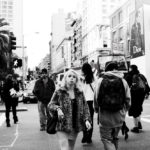This is the second guest post in the LOOK3 series in which Peter Earl McCollough documents his year working with the M9. You can read his first guest post published in January.
The more I invest my energy and time into street photography, the more pronounced a certain question becomes. What is street photography? This is by no means a new question, as countless discussions and conclusions about what street photography is and is not, have taken place long before I even existed. With that said, what is interesting about the question for me, is the question itself. In other words, do I want to define what it is I do? What would be the purpose of this? Will it help me better understand who I am and where I’m going or will it distract me?
Last week, after a good conversation about street photography with Mark Murrmann, photo editor of Mother Jones and avid Leica street photographer, he suggested I sit down and read, “Bystander: A History of Street Photography.” So I went to the San Francisco library and spent some time with the book. I was most engaged by the conversation in the back of the book with Joel Meyerowitz. It was fascinating to hear about his experiences with Gary Winogrand and Diane Arbus. (On a side note, I was comforted to learn that Winogrand was right handed and left-eye dominant, as I am, which ostensibly caused his frequent use of the tilted frame).
While looking and reading through the book, I was quickly overwhelmed by the vast history and evolution of the genre. There were photographs I had never seen and important photographers I had never heard of. Again, I found myself in a position where I had to ask, “How much do I want to know?” Skipping through the text I was drawn to a quote from a photographer named, Robert Doisneau, whom I had never heard of until reading:
“If I took apart my old alarm clock, I could find out how it works, but afterwards I might not have a way to get up in the morning.”
It reminded me of a quote from David Lynch, a significant creative inspiration in my life:
“It’s better not to know so much about what things mean or how they might be interpreted or you’ll be too afraid to let things keep happening. Psychology destroys the mystery, this kind of magic quality. It can be reduced to certain neuroses or certain things, and since it is now named and defined, it’s lost its mystery and the potential for a vast, infinite experience.”
There is undoubtedly a wealth of information in the history of street photography that would potentially make me a better photographer, artist, maybe even human. But I don’t feel a need to explore what others have done or learned and I think this is a legitimate feeling. Does this lack of information or education result in a photographic naivety? Yes, and that is exactly what I want. A lack of awareness can be helpful in finding your own vision, or your own way, because it forces you to reference the personal and the honest and the authentically felt. Does this show in the work? I don’t know.
A friend of mine who is a writer recently told me that he thinks the writing workshops he attended as a teenager were detrimental, that by listening to others, his literary voice was set back years of potential progress. I feel much the same way. I am not saying we cannot or should not learn from those that have gone before us, because obviously there is much to learn, but that we should only search for inspiration where it feels natural. We should be careful about what we might let into our subconscious and more importantly, why. I’ve come to learn that the more analysis I do, the less honest and instinctive my work is. And the less I think about what I’m doing, the more satisfying the results.
It seems street photography is merely a reflection of whatever you want it to be. For me, I am happy to keep it as a tryst, a dance with what I do not understand. It is a sacred space that is not about climbing the industry hierarchy, historical dialogue, credibility, producing “good” work, etc. It is a method of photographing that has the least to do with photography, and the most to with what it means to be alive, here and now.
-Peter Earl McCollough
Peter Earl McCollough was born in Billings, Montana, in 1982 and grew up in Davis, California. Shortly after turning 18, he enlisted in the United States Marine Corps where he served from 2000-2004. After being honorably discharged he began studying photography in Sacramento. In 2008, after transferring to Ohio University, he received a Bachelor of Science in Visual Communication with an emphasis in Photojournalism.
He is currently a freelance photographer and aspiring cinematographer based in San Francisco. In his off time he likes to paint, especially watercolors, and work on his street photography. More photos can be seen on his website:http://www.petermccollough.com/.

Comments (8)